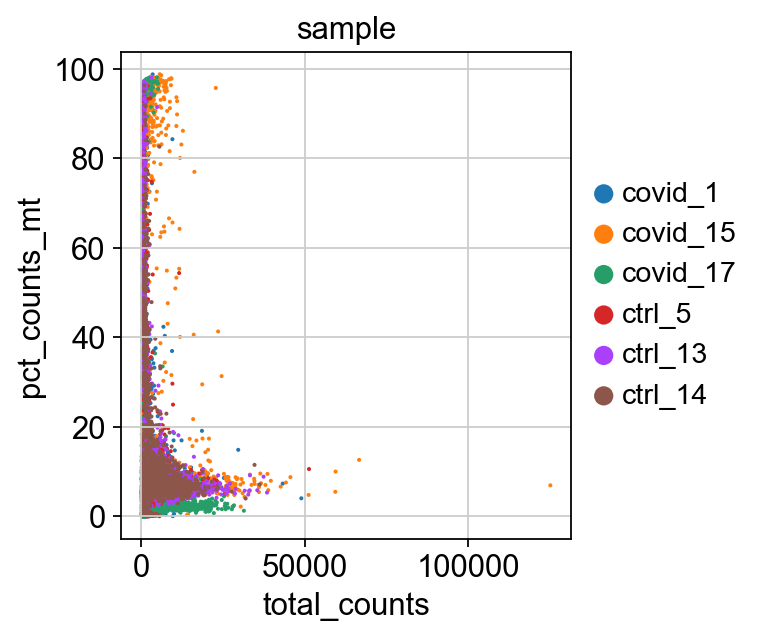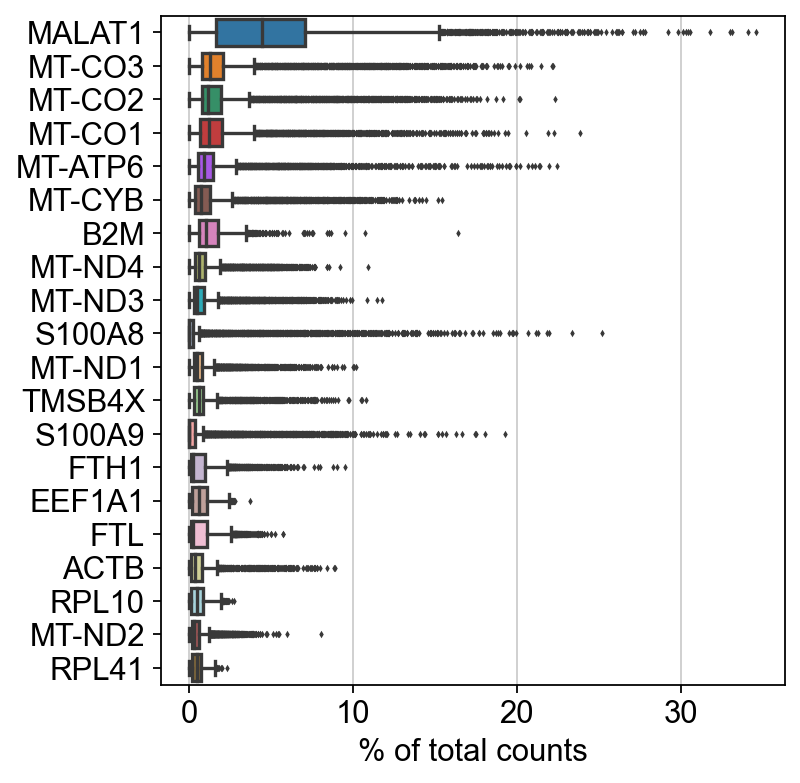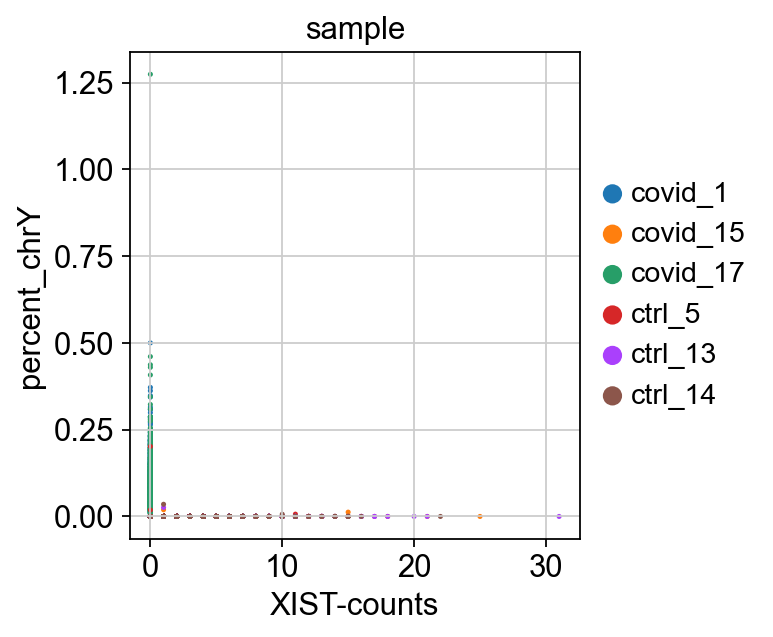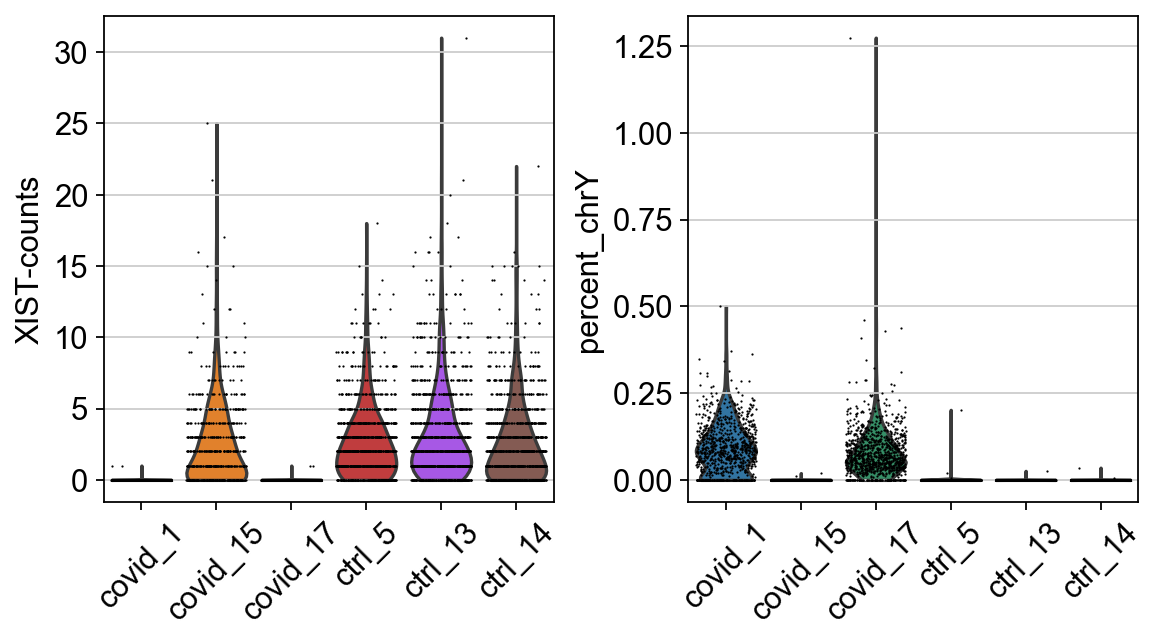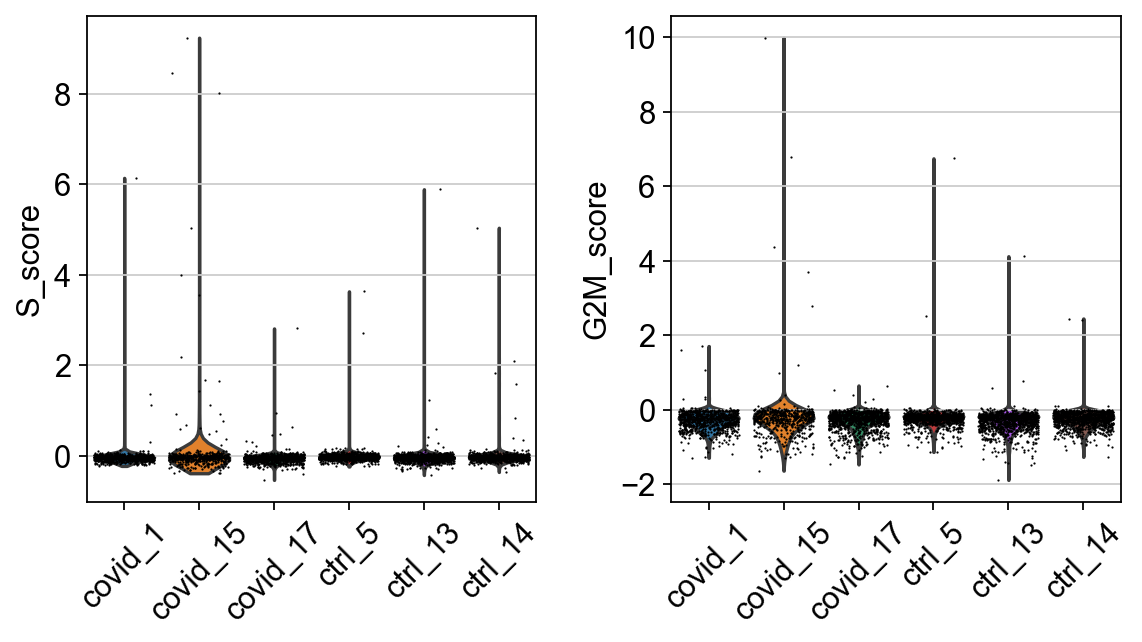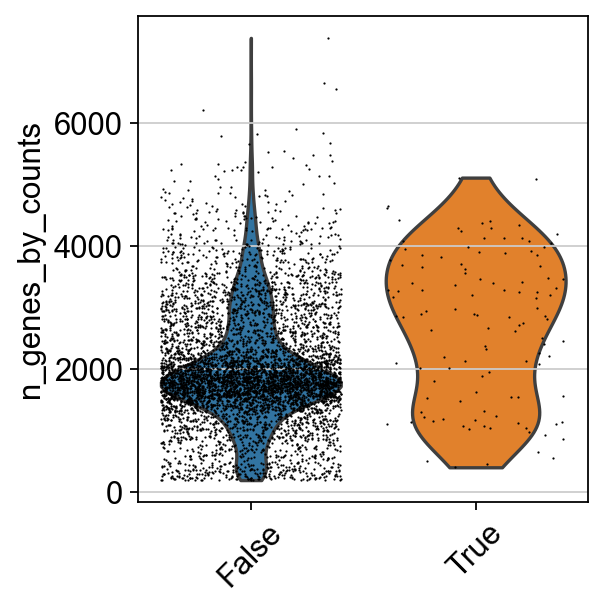Scanpy: Quality control¶
Get data¶
In this tutorial, we will run all tutorials with a set of 6 PBMC 10x datasets from 3 covid-19 patients and 3 healthy controls, the samples have been subsampled to 1500 cells per sample. They are part of the github repo and if you have cloned the repo they should be available in folder: labs/data/covid_data_GSE149689. Instructions on how to download them can also be found in the Precourse material.
%%bash
# create a data directory.
mkdir -p data/raw
# first check if the files are there
count=$(ls -l data/raw/*.h5 | grep -v ^d | wc -l )
echo $count
# if not 4 files, fetch the files from github.
if (("$count" < 6)); then
cd data/raw
curl -O https://raw.githubusercontent.com/NBISweden/workshop-scRNAseq/new_dataset/labs/data/covid_data_GSE149689/sub/Normal_PBMC_13.h5
curl -O https://raw.githubusercontent.com/NBISweden/workshop-scRNAseq/new_dataset/labs/data/covid_data_GSE149689/sub/Normal_PBMC_14.h5
curl -O https://raw.githubusercontent.com/NBISweden/workshop-scRNAseq/new_dataset/labs/data/covid_data_GSE149689/sub/Normal_PBMC_5.h5
curl -O https://raw.githubusercontent.com/NBISweden/workshop-scRNAseq/new_dataset/labs/data/covid_data_GSE149689/sub/nCoV_PBMC_15.h5
curl -O https://raw.githubusercontent.com/NBISweden/workshop-scRNAseq/new_dataset/labs/data/covid_data_GSE149689/sub/nCoV_PBMC_17.h5
curl -O https://raw.githubusercontent.com/NBISweden/workshop-scRNAseq/new_dataset/labs/data/covid_data_GSE149689/sub/nCoV_PBMC_1.h5
cd ../..
fi
ls -lGa data/raw
With data in place, now we can start loading libraries we will use in this tutorial.
import numpy as np
import pandas as pd
import scanpy as sc
sc.settings.verbosity = 3 # verbosity: errors (0), warnings (1), info (2), hints (3)
# gives error!! sc.logging.print_versions()
sc.settings.set_figure_params(dpi=80)
We can first load the data individually by reading directly from HDF5 file format (.h5).
data_cov1 = sc.read_10x_h5('./data/raw/nCoV_PBMC_1.h5')
data_cov1.var_names_make_unique()
data_cov15 = sc.read_10x_h5('./data/raw/nCoV_PBMC_15.h5')
data_cov15.var_names_make_unique()
data_cov17 = sc.read_10x_h5('./data/raw/nCoV_PBMC_17.h5')
data_cov17.var_names_make_unique()
data_ctrl5 = sc.read_10x_h5('./data/raw/Normal_PBMC_5.h5')
data_ctrl5.var_names_make_unique()
data_ctrl13 = sc.read_10x_h5('./data/raw/Normal_PBMC_13.h5')
data_ctrl13.var_names_make_unique()
data_ctrl14 = sc.read_10x_h5('./data/raw/Normal_PBMC_14.h5')
data_ctrl14.var_names_make_unique()
Create one merged object¶
# add some metadata
data_cov1.obs['type']="Covid"
data_cov1.obs['sample']="covid_1"
data_cov15.obs['type']="Covid"
data_cov15.obs['sample']="covid_15"
data_cov17.obs['type']="Covid"
data_cov17.obs['sample']="covid_17"
data_ctrl5.obs['type']="Ctrl"
data_ctrl5.obs['sample']="ctrl_5"
data_ctrl13.obs['type']="Ctrl"
data_ctrl13.obs['sample']="ctrl_13"
data_ctrl14.obs['type']="Ctrl"
data_ctrl14.obs['sample']="ctrl_14"
# merge into one object.
adata = data_cov1.concatenate(data_cov15, data_cov17, data_ctrl5, data_ctrl13, data_ctrl14)
# and delete individual datasets to save space
del(data_cov1, data_cov15, data_cov17)
del(data_ctrl5, data_ctrl13, data_ctrl14)
You can print a summary of the datasets in the Scanpy object, or a summary of the whole object.
print(adata.obs['sample'].value_counts())
adata
Calculate QC¶
Having the data in a suitable format, we can start calculating some quality metrics. We can for example calculate the percentage of mitocondrial and ribosomal genes per cell and add to the metadata. This will be helpfull to visualize them across different metadata parameteres (i.e. datasetID and chemistry version). There are several ways of doing this, and here manually calculate the proportion of mitochondrial reads and add to the metadata table.
Citing from "Simple Single Cell" workflows (Lun, McCarthy & Marioni, 2017): "High proportions are indicative of poor-quality cells (Islam et al. 2014; Ilicic et al. 2016), possibly because of loss of cytoplasmic RNA from perforated cells. The reasoning is that mitochondria are larger than individual transcript molecules and less likely to escape through tears in the cell membrane."
First, let Scanpy calculate some general qc-stats for genes and cells with the function sc.pp.calculate_qc_metrics, similar to calculateQCmetrics in Scater. It can also calculate proportion of counts for specific gene populations, so first we need to define which genes are mitochondrial, ribosomal and hemoglogin.
# mitochondrial genes
adata.var['mt'] = adata.var_names.str.startswith('MT-')
# ribosomal genes
adata.var['ribo'] = adata.var_names.str.startswith(("RPS","RPL"))
# hemoglobin genes.
adata.var['hb'] = adata.var_names.str.contains(("^HB[^(P)]"))
adata.var
sc.pp.calculate_qc_metrics(adata, qc_vars=['mt','ribo','hb'], percent_top=None, log1p=False, inplace=True)
Now you can see that we have additional data in the scanpy obs slot.
mito_genes = adata.var_names.str.startswith('MT-')
# for each cell compute fraction of counts in mito genes vs. all genes
# the `.A1` is only necessary as X is sparse (to transform to a dense array after summing)
adata.obs['percent_mt2'] = np.sum(
adata[:, mito_genes].X, axis=1).A1 / np.sum(adata.X, axis=1).A1
# add the total counts per cell as observations-annotation to adata
adata.obs['n_counts'] = adata.X.sum(axis=1).A1
Now you can see that we have additional data in the scanpy obs slot.
adata
Plot QC¶
Now we can plot some of the QC-features as violin plots.
sc.pl.violin(adata, ['n_genes_by_counts', 'total_counts', 'pct_counts_mt','pct_counts_ribo', 'pct_counts_hb'],
jitter=0.4, groupby = 'sample', rotation= 45)
As you can see, there is quite some difference in quality for the 4 datasets, with for instance the covid_15 sample having fewer cells with many detected genes and more mitochondrial content. As the ribosomal proteins are highly expressed they will make up a larger proportion of the transcriptional landscape when fewer of the lowly expressed genes are detected. And we can plot the different QC-measures as scatter plots.
sc.pl.scatter(adata, x='total_counts', y='pct_counts_mt', color="sample")
Filtering¶
A standard approach is to filter cells with low amount of reads as well as genes that are present in at least a certain amount of cells. Here we will only consider cells with at least 200 detected genes and genes need to be expressed in at least 3 cells. Please note that those values are highly dependent on the library preparation method used.
sc.pp.filter_cells(adata, min_genes=200)
sc.pp.filter_genes(adata, min_cells=3)
print(adata.n_obs, adata.n_vars)
Extremely high number of detected genes could indicate doublets. However, depending on the cell type composition in your sample, you may have cells with higher number of genes (and also higher counts) from one cell type.
In this case, we will run doublet prediction further down, so we will skip this step now, but the code below is an example of how it can be run:
# skip for now as we are doing doublet prediction
#keep_v2 = (adata.obs['n_genes_by_counts'] < 2000) & (adata.obs['n_genes_by_counts'] > 500) & (adata.obs['lib_prep'] == 'v2')
#print(sum(keep_v2))
# filter for gene detection for v3
#keep_v3 = (adata.obs['n_genes_by_counts'] < 4100) & (adata.obs['n_genes_by_counts'] > 1000) & (adata.obs['lib_prep'] != 'v2')
#print(sum(keep_v3))
# keep both sets of cells
#keep = (keep_v2) | (keep_v3)
#print(sum(keep))
#adata = adata[keep, :]
#print("Remaining cells %d"%adata.n_obs)
Additionally, we can also see which genes contribute the most to such reads. We can for instance plot the percentage of counts per gene.
sc.pl.highest_expr_genes(adata, n_top=20)
As you can see, MALAT1 constitutes up to 30% of the UMIs from a single cell and the other top genes are mitochondrial and ribosomal genes. It is quite common that nuclear lincRNAs have correlation with quality and mitochondrial reads, so high detection of MALAT1 may be a technical issue. Let us assemble some information about such genes, which are important for quality control and downstream filtering.
Mito/Ribo filtering¶
We also have quite a lot of cells with high proportion of mitochondrial and low proportion ofribosomal reads. It could be wise to remove those cells, if we have enough cells left after filtering.
Another option would be to either remove all mitochondrial reads from the dataset and hope that the remaining genes still have enough biological signal.
A third option would be to just regress out the percent_mito variable during scaling. In this case we had as much as 99.7% mitochondrial reads in some of the cells, so it is quite unlikely that there is much cell type signature left in those.
Looking at the plots, make reasonable decisions on where to draw the cutoff. In this case, the bulk of the cells are below 20% mitochondrial reads and that will be used as a cutoff. We will also remove cells with less than 5% ribosomal reads.
# filter for percent mito
adata = adata[adata.obs['pct_counts_mt'] < 20, :]
# filter for percent ribo > 0.05
adata = adata[adata.obs['pct_counts_ribo'] > 5, :]
print("Remaining cells %d"%adata.n_obs)
As you can see, a large proportion of sample covid_15 is filtered out. Also, there is still quite a lot of variation in percent_mito, so it will have to be dealt with in the data analysis step. We can also notice that the percent_ribo are also highly variable, but that is expected since different cell types have different proportions of ribosomal content, according to their function.
Plot filtered QC¶
Lets plot the same QC-stats another time.
sc.pl.violin(adata, ['n_genes_by_counts', 'total_counts', 'pct_counts_mt','pct_counts_ribo', 'pct_counts_hb'],
jitter=0.4, groupby = 'sample', rotation = 45)
Filter genes¶
As the level of expression of mitochondrial and MALAT1 genes are judged as mainly technical, it can be wise to remove them from the dataset bofore any further analysis.
malat1 = adata.var_names.str.startswith('MALAT1')
# we need to redefine the mito_genes since they were first
# calculated on the full object before removing low expressed genes.
mito_genes = adata.var_names.str.startswith('MT-')
hb_genes = adata.var_names.str.contains('^HB[^(P)]')
remove = np.add(mito_genes, malat1)
remove = np.add(remove, hb_genes)
keep = np.invert(remove)
adata = adata[:,keep]
print(adata.n_obs, adata.n_vars)
Sample sex¶
When working with human or animal samples, you should ideally constrain you experiments to a single sex to avoid including sex bias in the conclusions. However this may not always be possible. By looking at reads from chromosomeY (males) and XIST (X-inactive specific transcript) expression (mainly female) it is quite easy to determine per sample which sex it is. It can also bee a good way to detect if there has been any sample mixups, if the sample metadata sex does not agree with the computational predictions.
To get choromosome information for all genes, you should ideally parse the information from the gtf file that you used in the mapping pipeline as it has the exact same annotation version/gene naming. However, it may not always be available, as in this case where we have downloaded public data. Hence, we will use biomart to fetch chromosome information.
annot = sc.queries.biomart_annotations(
"hsapiens",
["ensembl_gene_id", "external_gene_name", "start_position", "end_position", "chromosome_name"],
).set_index("external_gene_name")
#>>> adata.var[annot.columns] = annot
Now that we have the chromosome information, we can calculate per cell the proportion of reads that comes from chromosome Y.
chrY_genes = adata.var_names.intersection(annot.index[annot.chromosome_name == "Y"])
chrY_genes
adata.obs['percent_chrY'] = np.sum(
adata[:, chrY_genes].X, axis=1).A1 / np.sum(adata.X, axis=1).A1 * 100
Then plot XIST expression vs chrY proportion. As you can see, the samples are clearly on either side, even if some cells do not have detection of either.
# color inputs must be from either .obs or .var, so add in XIST expression to obs.
adata.obs["XIST-counts"] = adata.X[:,adata.var_names.str.match('XIST')].toarray()
sc.pl.scatter(adata, x='XIST-counts', y='percent_chrY', color="sample")
Plot as violins.
sc.pl.violin(adata, ["XIST-counts", "percent_chrY"], jitter=0.4, groupby = 'sample', rotation= 45)
Here, we can see clearly that we have two males and 4 females, can you see which samples they are? Do you think this will cause any problems for downstream analysis? Discuss with your group: what would be the best way to deal with this type of sex bias?
Calculate cell-cycle scores¶
We here perform cell cycle scoring. To score a gene list, the algorithm calculates the difference of mean expression of the given list and the mean expression of reference genes. To build the reference, the function randomly chooses a bunch of genes matching the distribution of the expression of the given list. Cell cycle scoring adds three slots in data, a score for S phase, a score for G2M phase and the predicted cell cycle phase.
First read the file with cell cycle genes, from Regev lab and split into S and G2M phase genes. Cell cycle genes were retrieved from the scanpy_usage github site via web browser at RegevLab Github repo.
!if [ ! -f data/regev_lab_cell_cycle_genes.txt ]; then curl -o data/regev_lab_cell_cycle_genes.txt https://raw.githubusercontent.com/theislab/scanpy_usage/master/180209_cell_cycle/data/regev_lab_cell_cycle_genes.txt; fi
cell_cycle_genes = [x.strip() for x in open('./data/regev_lab_cell_cycle_genes.txt')]
print(len(cell_cycle_genes))
# Split into 2 lists
s_genes = cell_cycle_genes[:43]
g2m_genes = cell_cycle_genes[43:]
cell_cycle_genes = [x for x in cell_cycle_genes if x in adata.var_names]
print(len(cell_cycle_genes))
Before running cell cycle we have to normalize the data. In the scanpy object, the data slot will be overwritten with the normalized data. So first, save the raw data into the slot raw.
Then run normalization, logarimize and scale the data.
# save normalized counts in raw slot.
adata.raw = adata
# normalize to depth 10 000
sc.pp.normalize_per_cell(adata, counts_per_cell_after=1e4)
# logaritmize
sc.pp.log1p(adata)
# scale
sc.pp.scale(adata)
We here perform cell cycle scoring. The function is actually a wrapper to sc.tl.score_gene_list, which is launched twice, to score separately S and G2M phases. Both sc.tl.score_gene_list and sc.tl.score_cell_cycle_genes are a port from Seurat and are supposed to work in a very similar way. To score a gene list, the algorithm calculates the difference of mean expression of the given list and the mean expression of reference genes. To build the reference, the function randomly chooses a bunch of genes matching the distribution of the expression of the given list. Cell cycle scoring adds three slots in data, a score for S phase, a score for G2M phase and the predicted cell cycle phase.
sc.tl.score_genes_cell_cycle(adata, s_genes=s_genes, g2m_genes=g2m_genes)
We can now plot a violin plot for the cell cycle scores as well.
sc.pl.violin(adata, ['S_score', 'G2M_score'],
jitter=0.4, groupby = 'sample', rotation=45)
In this case it looks like we only have a few cycling cells in the datasets.
Predict doublets¶
Doublets/Mulitples of cells in the same well/droplet is a common issue in scRNAseq protocols. Especially in droplet-based methods whith overloading of cells. In a typical 10x experiment the proportion of doublets is linearly dependent on the amount of loaded cells. As indicated from the Chromium user guide, doublet rates are about as follows:
 Most doublet detectors simulates doublets by merging cell counts and predicts doublets as cells that have similar embeddings as the simulated doublets. Most such packages need an assumption about the number/proportion of expected doublets in the dataset. The data you are using is subsampled, but the orignial datasets contained about 5 000 cells per sample, hence we can assume that they loaded about 9 000 cells and should have a doublet rate at about 4%.
OBS! Ideally doublet prediction should be run on each sample separately, especially if your different samples have different proportions of celltypes. In this case, the data is subsampled so we have very few cells per sample and all samples are sorted PBMCs so it is okay to run them together.
Most doublet detectors simulates doublets by merging cell counts and predicts doublets as cells that have similar embeddings as the simulated doublets. Most such packages need an assumption about the number/proportion of expected doublets in the dataset. The data you are using is subsampled, but the orignial datasets contained about 5 000 cells per sample, hence we can assume that they loaded about 9 000 cells and should have a doublet rate at about 4%.
OBS! Ideally doublet prediction should be run on each sample separately, especially if your different samples have different proportions of celltypes. In this case, the data is subsampled so we have very few cells per sample and all samples are sorted PBMCs so it is okay to run them together.
For doublet detection, we will use the package Scrublet, so first we need to get the raw counts from adata.raw.X and run scrublet with that matrix. Then we add in the doublet prediction info into our anndata object.
Doublet prediction should be run for each dataset separately, so first we need to split the adata object into 6 separate objects, one per sample and then run scrublet on each of them.
import scrublet as scr
# split per batch into new objects.
batches = adata.obs['sample'].cat.categories.tolist()
alldata = {}
for batch in batches:
tmp = adata[adata.obs['sample'] == batch,]
print(batch, ":", tmp.shape[0], " cells")
scrub = scr.Scrublet(tmp.raw.X)
out = scrub.scrub_doublets(verbose=False, n_prin_comps = 20)
alldata[batch] = pd.DataFrame({'doublet_score':out[0],'predicted_doublets':out[1]},index = tmp.obs.index)
print(alldata[batch].predicted_doublets.sum(), " predicted_doublets")
# add predictions to the adata object.
scrub_pred = pd.concat(alldata.values())
adata.obs['doublet_scores'] = scrub_pred['doublet_score']
adata.obs['predicted_doublets'] = scrub_pred['predicted_doublets']
sum(adata.obs['predicted_doublets'])
We should expect that two cells have more detected genes than a single cell, lets check if our predicted doublets also have more detected genes in general.
# add in column with singlet/doublet instead of True/Fals
%matplotlib inline
adata.obs['doublet_info'] = adata.obs["predicted_doublets"].astype(str)
sc.pl.violin(adata, 'n_genes_by_counts',
jitter=0.4, groupby = 'doublet_info', rotation=45)
Now, lets run PCA and UMAP and plot doublet scores onto umap to check the doublet predictions.
sc.pp.highly_variable_genes(adata, min_mean=0.0125, max_mean=3, min_disp=0.5)
adata = adata[:, adata.var.highly_variable]
sc.pp.regress_out(adata, ['total_counts', 'pct_counts_mt'])
sc.pp.scale(adata, max_value=10)
sc.tl.pca(adata, svd_solver='arpack')
sc.pp.neighbors(adata, n_neighbors=10, n_pcs=40)
sc.tl.umap(adata)
sc.pl.umap(adata, color=['doublet_scores','doublet_info','sample'])
Now, lets remove all predicted doublets from our data.
# also revert back to the raw counts as the main matrix in adata
adata = adata.raw.to_adata()
adata = adata[adata.obs['doublet_info'] == 'False',:]
print(adata.shape)
Save data¶
Finally, lets save the QC-filtered data for further analysis. Create output directory results and save data to that folder.
import os
os.makedirs('data/results/', exist_ok=True)
save_file = 'data/results/scanpy_qc_filtered_covid.h5ad'
adata.write_h5ad(save_file)

